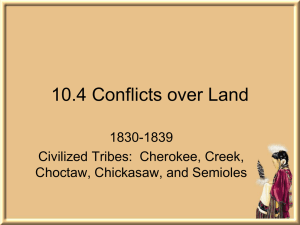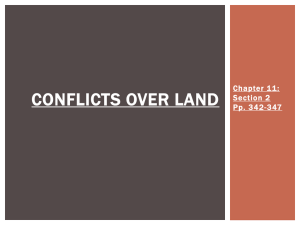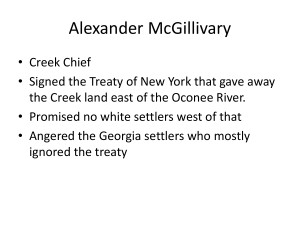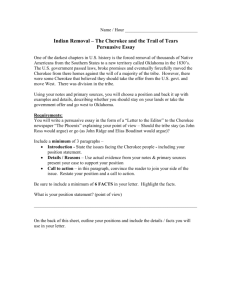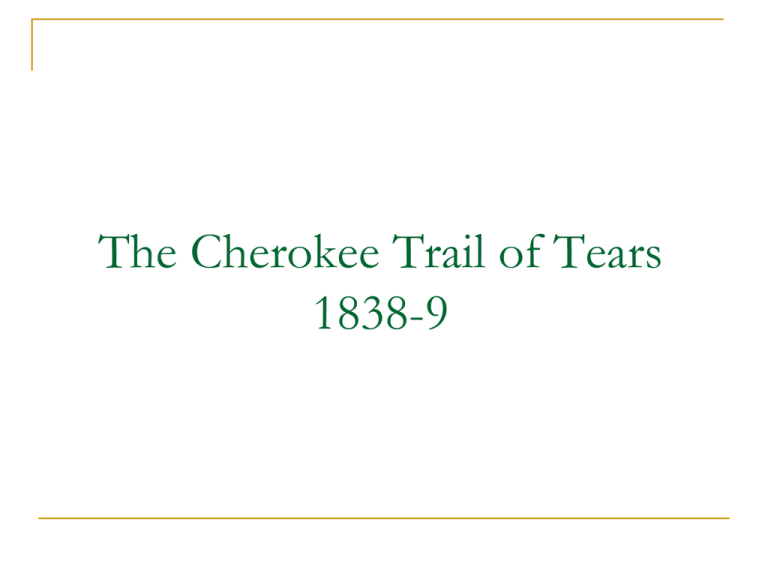
The Cherokee Trail of Tears
1838-9
Key Historical Points
Nation vs. nation – U.S. vs. Cherokee
Example of U.S. gov’t “Removal policy”
Multicultural and complex – NOT just Red vs.
White
All Southeastern tribes forced West of
Mississippi River
Example of the major conflicts and tensions
in nineteenth century U.S.
Nation vs. Nation – Background
Population growth, cotton boom
Cherokee economic success
Interaction with whites – missionaries,
marriages, customs
Competing claims – Cherokee vs. Georgia
Trigger – Georgia gold rush
U.S. Government’s Removal Policy
Thomas Jefferson, 1802
Indian Removal Act, 1830
Supreme Court rulings
Cherokee Nation v. Georgia, 1831
Worcester v. Georgia, 1832
President Andrew Jackson
Treaty of New Echota, 1835
Basic Facts – Trail of Tears
Pro-removal Cherokee in the minority
(100-200 people)
Most Cherokee against moving
(10,000 people sign petition)
Most whites across the country supported
removal policy
Davy Crockett against removal:
“I would sooner be honestly
damned than hypocritically
immortalized.”
Basic facts – Cherokee Trail of Tears
16,000 Cherokee moved 1,200 miles from Northern
Georgia to Oklahoma
Basic Facts – Trail of Tears
Summer 1838 to Spring 1839
Forcibly moved by U.S. Army and state
militias
4,000 Cherokee died along the way, from:
Exposure
Disease, malnutrition
Violence from settlers and soldiers
Nunadautsun't – “The Trail Where We Cried”
Nation vs. Nation – The Cherokee Nation
Parallel assimilation
Government – same as U.S.
Economy – plantations, slavery
Courts, legal system
Matrilineal to patrilineal system
Nation vs. Nation – The Cherokee Nation
Nationalism
Sovereignty and legal
recognition
Capital city – New
Echota
Newspaper:
The Cherokee
Phoenix
Central Conflicts in Nineteenth Century
America
U.S. Constitution
State vs. federal government
Government vs. private citizens
President vs. Supreme Court
Native American tribes – sovereign or not?
Central Conflicts in Nineteenth Century
America
Native American societies
Assimilate or resist?
If assimilate, how much?
Membership – who counts?
Racial and ethnic division
“Mixed” vs. “full-blooded”
White settlers vs. Native Americans
Racist double standards
Divisions within ethnic groups
© 2011, The McGraw-Hill
Companies, Inc. All Rights
Reserved.
The Expulsion of the Tribes, 1830-1835
13
Other Trails of Tears – Southeast
Other Trails of Tears – Nationwide
Historical Legacies – Native Americans
Oklahoma becomes “Indian Territory”
Cherokee politics, divisions
Cherokee in the Civil War
Native American memory
Inspired resistance
Trail commemorations
Cherokee Rose
Historical Legacies – U.S. History
Federal government, military role
Reservation system
Indian wars, late nineteenth century
Success Story: Will Rogers

